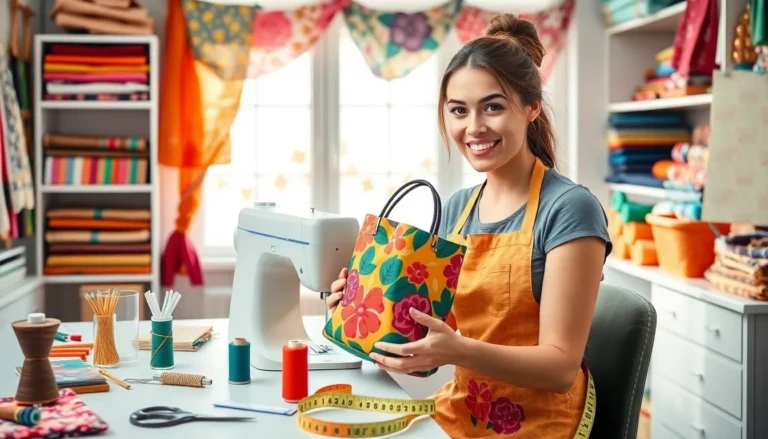Picture this: a cluttered kitchen, a chaotic craft room, or a disorganized garage. Now imagine transforming that mess into a masterpiece with just a rolling cart and a sprinkle of creativity. Rolling carts are the unsung heroes of organization, offering a mobile solution that can adapt to any space. Whether it’s for storing art supplies or kitchen essentials, a DIY rolling cart can be both functional and stylish.
Overview of Rolling Cart DIY
Rolling carts serve as a functional solution for organizing different materials in various environments. They adapt easily to kitchens, craft rooms, and garages, offering both convenience and style. These DIY projects enhance both utility and aesthetic appeal.
Creating a rolling cart involves selecting suitable materials, such as wood or metal, and determining the desired dimensions. Consider customizing the cart to suit specific needs; for instance, adding shelves for kitchen supplies or drawers for art materials. The process often starts with a clear design plan that outlines features and dimensions.
Tools such as screws, wheels, and a drill play a crucial role in building these carts. Proper assembly ensures stability, allowing the cart to hold substantial weight. Using paint or stain can further personalize the piece and enhance its look.
Repurposing old furniture for a rolling cart project can save costs while promoting sustainability. Using materials like an old dresser or a wooden pallet simplifies the DIY process and adds character. Incorporating functional elements like hooks or baskets maximizes storage space.
Plans for adding decorative elements might involve choosing colors that complement existing decor. DIY enthusiasts often opt for a modern finish or a rustic look, based on personal taste and functionality needs. Successful projects result in unique pieces that serve vital roles in everyday organization.
Consider this approach not just for home use, but also for office environments. Rolling carts provide mobility, making it easy to transport materials between locations. They serve as excellent options for temporary workspaces or craft fairs. Each cart embodies creativity mixed with practicality, making it a worthwhile endeavor.
Benefits of DIY Rolling Carts
Creating DIY rolling carts brings numerous advantages for personal and organizational needs. The ability to tailor projects leads to unique solutions that suit any space.
Customization Options
Customization stands out as a key benefit of DIY rolling carts. Individuals can choose colors, materials, and sizes that match specific styles or preferences. Personalization allows for integration of features such as shelving heights or drawer configurations based on individual storage needs. Custom decals or paint techniques can transform the cart into a stylish centerpiece. Flexibility in design means users can adapt their carts for various functions, from storage to display, enhancing both utility and aesthetics.
Cost-Effectiveness
Cost-effectiveness plays a significant role in the appeal of DIY rolling carts. Building a cart from repurposed materials saves money compared to purchasing prefabricated options. Selecting items like old furniture or discarded wood reduces costs while promoting sustainability. Comparing prices for raw materials, tools, and hardware can reveal savings that lead to an affordable final product. By investing time in DIY projects, individuals often create high-quality solutions tailored to their specific needs without overspending.
Essential Materials and Tools
Choosing the right materials and tools simplifies the DIY rolling cart project. It enhances both functionality and aesthetics.
Common Materials
Plywood serves as a sturdy base for the cart structure. Metal brackets add strength to the joints, ensuring durability. R wheels provide mobility and ease of movement. Paint or wood stain allows for customization, matching personal style. Screws and nails secure components in place, reinforcing stability. Lastly, handles enhance user convenience, making the cart easy to maneuver.
Recommended Tools
A drill speeds up assembly, making the process efficient. A saw cuts materials to the desired dimensions, ensuring precise sizes. Sandpaper smooths edges for a polished finish, enhancing safety and aesthetics. A measuring tape ensures accuracy in measurements. Clamps hold pieces together while assembling, preventing shifting. Finally, a level guarantees that the cart stands evenly, improving functionality.
Step-by-Step Guide to Creating Your Rolling Cart
Creating a DIY rolling cart involves thoughtful planning, efficient assembly, and enjoyable finishing touches. Follow these steps to construct a cart that meets specific needs.
Planning Your Design
Begin by visualizing the cart’s purpose. Determine storage needs, such as art supplies or kitchen essentials, to guide design choices. Choose dimensions that fit available space while maintaining mobility. Sketch layout ideas, considering shelf height and overall structure. Select materials based on desired aesthetic and durability. Plywood, metal, and paint options play crucial roles in realizing your vision. Identify features like handles or additional shelves to enhance functionality and tailor it to personal preferences.
Assembling the Cart
Start with gathering tools and materials listed earlier. Assemble the cart frame by cutting plywood to desired sizes. Utilize metal brackets at joints for added stability. Drill pilot holes to prevent plywood from splitting during assembly. Attach shelves securely, ensuring they sit level. Fix wheels to the bottom corners, opting for lockable options to enhance stability during use. Check the cart’s balance when standing, making adjustments as necessary. Ensure everything is securely fastened for safety and durability.
Finishing Touches
Refine the cart’s appearance with paint or wood stain, applying several thin coats for an even finish. Customize colors based on personal style, making the cart blend with existing decor. Install any additional features, such as hooks or containers, to further boost functionality. Allow paint to cure fully before using the cart. Add organization tools, like baskets or dividers, to keep items neatly arranged. Step back and evaluate the final product, ensuring it meets both aesthetic and practical expectations.
Creative Uses for DIY Rolling Carts
DIY rolling carts serve various purposes that maximize organization and functionality in different areas of life.
Organizing Spaces
Rolling carts effectively streamline clutter in kitchens, offices, and living rooms. They provide essential storage for items like utensils, paperwork, and craft supplies. Mobility allows easy repositioning, adapting to different layouts or activities. Carts may include labeled bins, baskets, or shelves, offering systematic storage solutions. Rolling carts promote accessibility, making it simple to grab items on the go. Using decorative finishes or colors adds personal style while maintaining organization.
Unique Projects
Unique projects transform ordinary rolling carts into remarkable functional pieces. Individuals can upcycle old furniture, making carts that reflect personal taste and creativity. For example, an old dresser can become a multifaceted cart with added wheels and a fresh coat of paint. Some people incorporate specialized features like hooks for kitchen utensils or removable trays for crafting. Innovative designs might include tiered shelves, hidden compartments, or adjustable heights to cater to diverse needs. Tailoring these projects fosters both creativity and practicality, resulting in captivating solutions for home or work environments.
DIY rolling carts offer a fantastic way to enhance organization and style in any space. By personalizing these carts to fit individual needs and preferences, one can create a functional piece that complements their decor. The process of building a rolling cart not only fosters creativity but also promotes sustainability through the use of repurposed materials.
Whether for the kitchen, office, or craft room, these carts provide mobility and versatility. With a bit of planning and the right tools, anyone can transform their cluttered areas into orderly and visually appealing spaces. Embracing DIY rolling carts is a practical choice that brings both efficiency and charm to everyday life.






